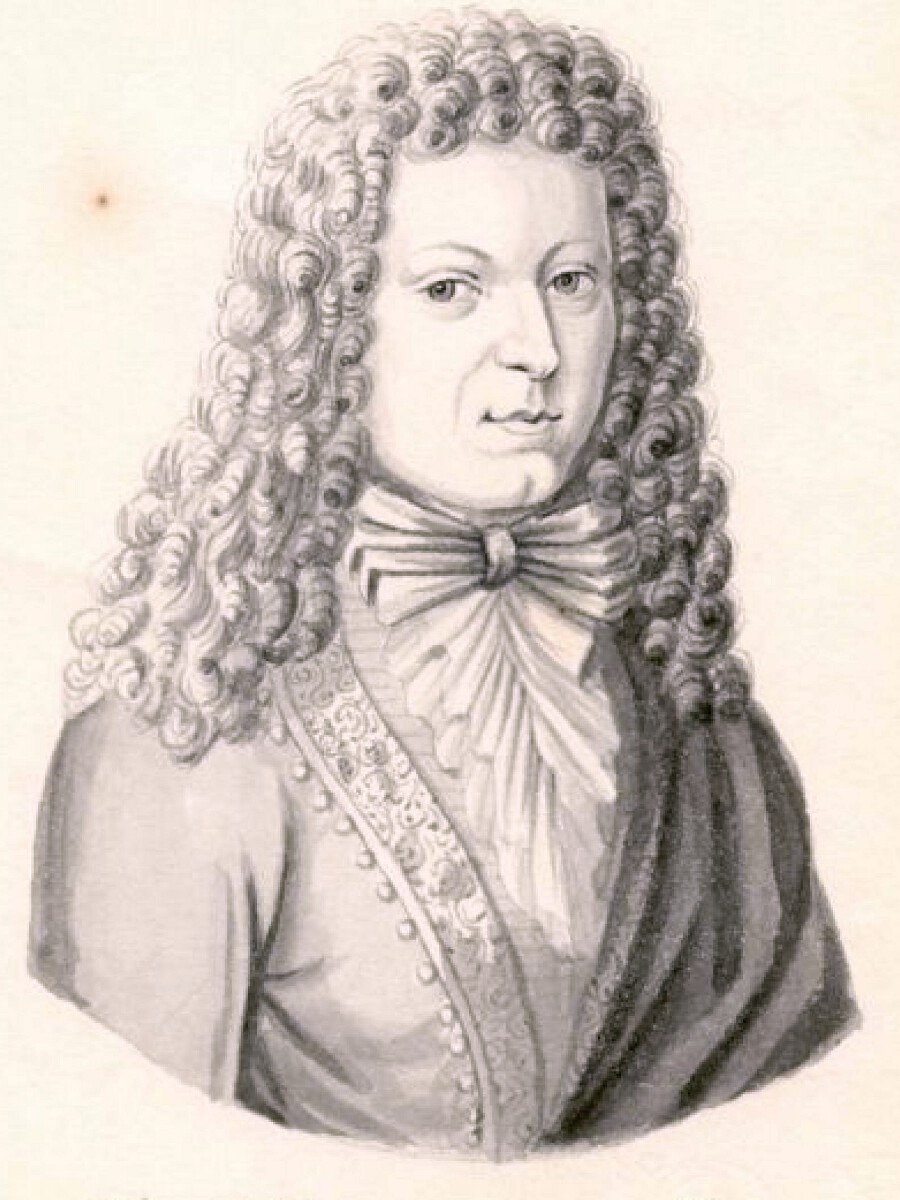This year, the revolving authors of our Henle editors’ blog are addressing composer anniversaries at regular intervals, alongside a host of exciting special topics. Just a fortnight ago, my colleague Peter Jost celebrated César Franck’s 200th birthday. Today I’m taking a big step back in music history and commemorating Johann Kuhnau (born 6 April 1660), who died 300 years ago yesterday. Milestone birthdays are generally easier to celebrate than death anniversaries. But yesterday’s 300th anniversary of Kuhnau’s death (5 June 1722) presents an optimal occasion for taking a closer look at this fascinating personality from the 17th/18th centuries.
I would like to begin with music – funeral music, fitting for the anniversary of his death. For one of Kuhnau’s best-known works is the motet “Tristis est anima mea” for Maundy Thursday (although his authorship has recently been disputed…). Considering this highly expressive, moving music, I ask myself: why don’t we hear more from Kuhnau? And with this question we are already right at the centre of one of the Kuhnau problems. A large part of his oeuvre is no longer extant, not to mention the several works of doubtful authenticity (such as the motet “Tristis est anima mea”). Have a look at the works’ list in the Wikipedia entry (in German language; please scroll down to “Werke (summarisch)” and have a look at the entries labelled “verschollen” [lost] or “zweifelhafte Autorschaft” [doubtful authorship]). As quite obviously this situation is not a favourable basis for appreciating the work of an artist, our picture of the composer Kuhnau must inevitably remain incomplete and blurred. What a pity, for who knows what treasures have been lost to us there….
But what do we know about Kuhnau? The answer heard most frequently leads us straight to the next Kuhnau problem. He was Johann Sebastian Bach’s predecessor as cantor at the Leipzig St. Thomas church. A sad outcome, indeed, when a composer’s best-known biographical detail refers to another composer, in whose powerful shadow Kuhnau stands in posterity’s musico-historical perception! To be overshadowed by competitors – this fate threatened Kuhnau even during his lifetime. For concurrently, the young Georg Philipp Telemann was also working in Leipzig, quickly attracting an enthusiastic audience and so persuasive that Leipzig city councillors withdrew key components of Kuhnau’s duties and handed them over to Telemann. This led to protracted quarrels between Kuhnau and his employers. “The wild operatic attitude” that Telemann struck, from Kuhnau’s point of view, pushed the latter to the margins of musical activity.
Yet Kuhnau had extraordinarily much to offer. Besides music, law was his second mainstay. With a doctorate in law, he practised at length as a lawyer, was considered an extensively educated scholar and even published a satirical novel during his lifetime.
 Of lasting value are the cycles of works for keyboard instruments that he self-published: Two series of suites (Clavier Übung, parts I & II), the Frische Clavier Früchte [Fresh Keyboard Fruits] and the Musicalische Vorstellung einiger biblischer Historien [Biblical Sonatas]. All his works for keyboard instruments were published in 2014 by G. Henle Verlag in an anthology.
Of lasting value are the cycles of works for keyboard instruments that he self-published: Two series of suites (Clavier Übung, parts I & II), the Frische Clavier Früchte [Fresh Keyboard Fruits] and the Musicalische Vorstellung einiger biblischer Historien [Biblical Sonatas]. All his works for keyboard instruments were published in 2014 by G. Henle Verlag in an anthology.
The most popular are certainly the works often called “Biblical Sonatas”, because they are particularly fine examples of programmatically-inspired Baroque music. In each of these six sonatas, Kuhnau takes a biblical theme from the Old Testament and tone-paints various scenes (clarifying with the help of headings the respective events in the music text). As an example, here is a page from the 1st sonata, with the topic “David against Goliath”. Kuhnau very vividly composes David’s hurling of the stone and Goliath’s falling.
 The entire sonata (with translated texts – and pictorial material, though not coming from Kuhnau) can be followed along here very well.
The entire sonata (with translated texts – and pictorial material, though not coming from Kuhnau) can be followed along here very well.
Personally, however, I much prefer the “free” compositions, the suites of the two Clavierübungen (e.g., No. V, or the wonderful Aria from the Suite VI), though the Clavier Früchte are also extremely appealing. In formal terms, they are Baroque ensemble sonatas, though Kuhnau is, by writing for a keyboard instrument, one of the first composers to invent sonatas for “clavier [keyboard instruments]”. To be discovered are manifold forms between trio sonata and concerto. Tonally, rhythmically and harmonically, this is exceptionally attractive music that can, of course, also be perfectly well performed on the modern piano or grand piano.
 I can only recommend that you embark on a voyage of discovery through this musical cosmos no longer very present to us. That should not obscure the fact that Kuhnau’s publications were very successful during his lifetime, with even Charles Burney’s report in 1775, a full 50 years after Kuhnau’s death, that: “He composed […] (especially important) harpsichord sonatas, which are still available and played.” At a time when, for the most part, only what had just been freshly composed was played, when the idea of a repertoire was not yet fully developed, it is astonishing that Kuhnau’s keyboard works were obviously still part of general musical practice.
I can only recommend that you embark on a voyage of discovery through this musical cosmos no longer very present to us. That should not obscure the fact that Kuhnau’s publications were very successful during his lifetime, with even Charles Burney’s report in 1775, a full 50 years after Kuhnau’s death, that: “He composed […] (especially important) harpsichord sonatas, which are still available and played.” At a time when, for the most part, only what had just been freshly composed was played, when the idea of a repertoire was not yet fully developed, it is astonishing that Kuhnau’s keyboard works were obviously still part of general musical practice.
The numerous printed exemplars surviving to this day attest to this wide dissemination. Since Kuhnau’s prints were repeatedly reprinted, a wide range of sources has been preserved, confronting the editor (myself), however, with completely new editorial problems. When comparing sources, it quickly became evident that Kuhnau took the opportunity of correcting his works whilst reprinting them. These correction pages were not always included in new editions, as pages from older, still available stages were sometimes used, instead. Paradoxically, new editions (which can quickly be identified as such by the new title pages) therefore sometimes contain old, now obsolete text, necessitating decisions on a case-by-case basis as to which sections of the source material actually transmitted the ultimate, definitive version. Anyone interested in cracking such hard “philological nuts” is advised to take a look at the Critical Report.
So, we cannot doubt Kuhnau’s success during his lifetime and beyond. I would wish that this success will receive a new boost – perhaps also occasioned by the 300th anniversary of his death.
And speaking of shadows: Who stood in whose shadow (Kuhnau or Bach) probably needs to be otherwise assessed from a historical perspective. Is it a coincidence that Bach, with his printed “Opus 1”, the 6 Partitas for Harpsichord BWV 825–830 of all things, echoes his predecessor in title and calls them “Clavier Übung”? The title may have been in general use, but Bach will certainly have paid tribute to the prints of Kuhnau’s “Clavier Übung” still circulating at the time.


Thank you, Dr. Müllemann, for this enlightening article on Kuhnau – a fine and sadly overlooked composer. I didn’t know there was a Henle edition. It shall go on my list of scores to acquire and cherish!